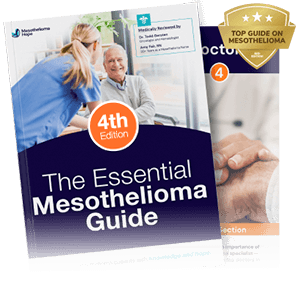Why Are Automotive Workers at Risk of Mesothelioma?
Many automotive workers serviced vehicles that used asbestos-containing products like brakes or insulation. These workers may have inhaled asbestos fibers, which can lead to cancer later in life.
Once asbestos enters the body, it lodges within the lining of the lungs or other organs and does not leave.
Over 10-50 years, the fibers irritate the body and can cause cancerous mesothelioma cells to develop. Automotive workers may also develop other asbestos-related diseases like lung cancer or asbestosis.
Each year, many mechanics, other asbestos automotive workers, or their loved ones get diagnosed with asbestos diseases like mesothelioma. Thankfully, victims affected by asbestos exposure can get treatments and financial payouts by working with our team.
Learn what resources may be available to your family in our Free Mesothelioma Guide, shipped overnight right to your door.
Automotive Workers at High Risk of Asbestos Exposure
Mechanics who handled automotive parts made with asbestos were at the highest risk of exposure. They may have been exposed to asbestos while removing or repairing auto parts, rebuilding vehicles, or performing vehicle maintenance.
Specific workers with a high risk of asbestos exposure include:
- Auto mechanics
- Automotive plant workers
- Brake mechanics
- Clutch repair workers
- Engine rebuilders
- Managers
- Military mechanics
- Staff in auto repair shops/garages (e.g., apprentices)
Auto workers who are also U.S. veterans are at an increased risk of mesothelioma, since all U.S. military branches used asbestos products from the 1930s until the early 1980s.
Secondhand Asbestos Exposure in Automotive Families
Family members and loved ones who lived with automotive workers may have been exposed to asbestos secondhand.
Asbestos automotive workers could unknowingly bring home fibers on their hair, skin, or clothes. Family members could then have been exposed when the workers came home. Further, anyone who worked on cars that used asbestos in their own home garages could kick up dust and put their loved ones at risk.
Many family members of auto mechanics who used asbestos have developed mesothelioma — even though they never actually worked on cars themselves — due to this secondhand exposure.
How Were Automotive Workers Exposed to Asbestos?
Prior to the early 1980s (when the health risks of asbestos became public knowledge), asbestos automotive workers regularly used products containing asbestos in cars and other vehicles.
Many daily tasks could have exposed mechanics to asbestos dust as a result.
Auto workers could come in contact with asbestos by:
- Assembling or packing asbestos products in factories
- Beveling, sanding, and grinding brakes
- Changing gaskets, heat seals, or hood liners
- Installing and changing asbestos brake pads
- Performing automotive bodywork
- Repairing transmissions
- Working on clutch parts or electrical wiring
- Spraying down asbestos dust with a hose
- Using a shop vacuum
- Using a dry cloth to clean up asbestos dust
Contact us now for free medical and financial resources after a mesothelioma diagnosis.
Asbestos in Automotive Products
Asbestos use was rampant in automotive brake pads, insulation, and many other car parts for decades. Asbestos automotive mechanics relied on this substance since it helped keep car parts fireproof and durable.
“We knew asbestos was in things but we didn’t know it was dangerous.”
— Dennis, Automotive Worker With Mesothelioma
Here are some asbestos auto parts workers may have handled:
- Brake pads, brake linings, and brake shoes
- Clutch parts, discs, facings, and linings
- Fume hoods
- Gaskets
- Hood liners
- Insulation (heat seals, heat shields, heat liners)
- Torque valves
- Transmission parts like housing and plates
- Valve rings
Handling asbestos-containing parts, removing them, or installing new parts would stir up asbestos dust. The workers would inhale this dust — sometimes on a daily basis.
Automotive Unions and Asbestos Exposure
Automotive industry unions were not safe from asbestos exposure. Many union workers were exposed to asbestos and later developed mesothelioma.
Members of these unions may have been exposed to asbestos:
- Delphi Chassis Kettering Operations
- General Motors of Ohio
- Indiana Local 907
- Indiana Visteon (Ford Motor Company)
- IUE-GM Delphi-Valeo-DMAX Conference Board
- Michigan Local 436A FW
- Meridian Automotive Systems (Michigan)
- Moraine Assembly
- Ohio Local 755
- Ohio Local 798
- United Automobile Workers Union (UAW)
Is Asbestos Still a Risk in the Automotive Industry?
Yes. Asbestos continues to put mechanics at risk if they don’t take proper safety measures when working on older vehicles that may have asbestos parts inside.
Asbestos is not normally used to make auto parts today. However, the Environmental Protection Agency (EPA) notes that some brakes and clutches still contain asbestos as of 2023.
However, there are now practices to help protect auto workers who could be exposed to asbestos in auto brakes, clutches, and other products.
Regulations of asbestos use include:
- Asbestos exposure workplace limits: The Occupational Safety and Health Administration (OSHA) set permissible limits for asbestos exposure in the workplace. Employers are not to exceed this limit and auto workers have the right to a hazard-free workplace.
- New possible chrysotile asbestos ban: The EPA proposed a ban on new uses of chrysotile asbestos (the most commonly used type in the U.S.) in 2022. It is currently awaiting a decision by Congress.
- Partial asbestos-containing products ban: Many, but not all, asbestos-containing products are banned by the EPA. The agency has also outlined guidelines to help keep mechanics working on brakes and clutches safe from asbestos exposure.
Still, many cases of mesothelioma in auto mechanics are reported every year in those who were exposed before these precautions were taken. This is because there’s no way to prevent mesothelioma in automotive workers who were already exposed.
If you were exposed to asbestos in auto parts and now have mesothelioma, we can help you find treatment and financial resources. Get all the details in our Free Mesothelioma Guide.
Preventing Asbestos Exposure in Auto Workers
Since asbestos is still a risk in auto workplaces, there are a number of measures mechanics and shop owners can take to safeguard against exposure.
Some of these prevention methods include:
- Wiping down areas with possible asbestos dust with a wet cloth — rather than spraying the area or using a dry rag.
- Using a high-efficiency particulate air (HEPA) vacuum to clean asbestos dust, as this specific type of vacuum helps keep dust enclosed so it does not linger in the air.
- Using a wet cleaning system or a device that wets potential asbestos and catches any residual product.
Treatment for Auto Workers With Mesothelioma
Auto mechanics with mesothelioma have a number of treatment options, including surgery, chemotherapy, radiation and clinical trials (emerging treatments).
Mesothelioma treatments vary from one person to the next. The treatment that will work for you or a loved one will depend on a number of factors, such as your health at the time of diagnosis, mesothelioma stage, and age.
If you seek treatment from top mesothelioma doctors, you’ll have access to the most effective forms of care and a team of specialists ready to help you.
We can help you find top mesothelioma doctors in your area. Use our Free Doctor Match to get started.
Compensation for Automotive Workers With Mesothelioma
Asbestos automotive workers with mesothelioma may be able to get financial compensation. Payments could help cover cancer treatment costs, the pain and suffering you have endured, and more.
Financial options for auto workers with mesothelioma include:
- Asbestos trust fund claims: Asbestos trust funds were established when certain asbestos product manufacturers filed for bankruptcy to avoid facing private lawsuits. You may qualify if your exposure to asbestos can be traced to certain asbestos-containing products. There’s over $30 billion available in these funds as of today.
- Mesothelioma lawsuits: It may be possible to file mesothelioma lawsuits against companies that don’t have asbestos trust funds. These lawsuits usually award between $1 million and $1.4 million on average.
- Veterans benefits: If you were a mechanic in the military, you may be able to apply for benefits from the U.S. Department of Veterans Affairs (VA). Currently, most mesothelioma VA benefits packages award nearly $4,000 a month and allow veterans to get medical treatment at little to no cost.
Settlements and Verdicts for Asbestos Automotive Workers
Mesothelioma lawsuits can award financial aid through either an out-of-court settlement or a trial verdict.
Notable settlements and verdicts for mesothelioma auto workers include:
- $34 million verdict against Ford Motor Company
- $20 million verdict against Ford
- $6.76 million in a mesothelioma settlement for a Florida auto mechanic
- $6 million verdict against Ford
- $4 million in settlements for an Illinois mechanic
- $3.14 million in settlements for a Michigan auto worker
All of the verdicts and settlements above were secured by Simmons Hanly Conroy, the official legal sponsor of Mesothelioma Hope and one of the nation’s top asbestos law firms.
Arthur “Art” Putt, a California auto mechanic and pleural mesothelioma survivor, received multiple life-changing mesothelioma settlements by working with the firm.
“We gave all that money to our kids, paid all their debts off, paid our house off and made our life a little easier because we had no financial worries.”
— Art Putt, Auto Mechanic With Mesothelioma
The mesothelioma lawyers at Simmons Hanly Conroy have secured more than $8.7 billion for clients across the country, including millions for auto mechanics. See if our legal partners can help with your case too during a free legal consultation.
How We Help Auto Workers Facing a Mesothelioma Diagnosis
If you’re an automotive mechanic with mesothelioma, you may be owed compensation for the harm you’ve suffered.
Mesothelioma Hope can connect you with top doctors, support groups, veterans resources, and much more.
Get Your Free Mesothelioma Guide to learn how we can help patients and families impacted by this disease.
Mesothelioma and Auto Mechanics FAQs
Do mechanics get exposed to asbestos?
Yes, car mechanics can be exposed to asbestos while repairing, building, or maintaining vehicles. Exposure occurs due to handling car parts made with asbestos-containing products.
Are car brakes still made with asbestos?
Yes, asbestos is still in some brakes and clutches, according to the EPA. This is because asbestos isn’t fully banned in the U.S. at this time.
Automotive workers must take extra care if they may be working with or around asbestos-containing car brakes.
How much asbestos are in car brakes?
According to the EPA, you cannot tell whether a vehicle contains asbestos brakes or other asbestos products simply by looking at them.
The EPA instructs that for new vehicles, you may be able to look at their labels (Material Safety Data Sheets) to find out what products the cars contain.
For older vehicles, the EPA advises that mechanics should assume all older vehicles (those manufactured before 1980) contain asbestos products and take proper precautions.
Why was asbestos used in brake pads?
Brake pads relied on asbestos to make them more durable and reduce friction.
Asbestos is very sturdy and naturally fireproof, so it was thought to be an ideal substance for use in brake pads, linings, and other brake components. However, exposure to asbestos is now known to cause mesothelioma.
Where is asbestos found in an auto shop?
Asbestos-containing products could be found all throughout auto shops. Car parts like brake pads, gaskets, and insulation were made with asbestos for decades on end.
Further, asbestos could be found lingering in the air in auto shops. As asbestos automotive workers performed their duties, fibers could get kicked up and anyone working in the shop could inhale or swallow them.
Are mechanics at risk of lung cancer?
Yes, mechanics may be at risk for developing asbestos-related lung cancer due to handling asbestos-containing car parts.
Asbestos exposure in mechanics and other auto workers can lead to lung cancer, mesothelioma, asbestosis, and other asbestos-related illnesses.



